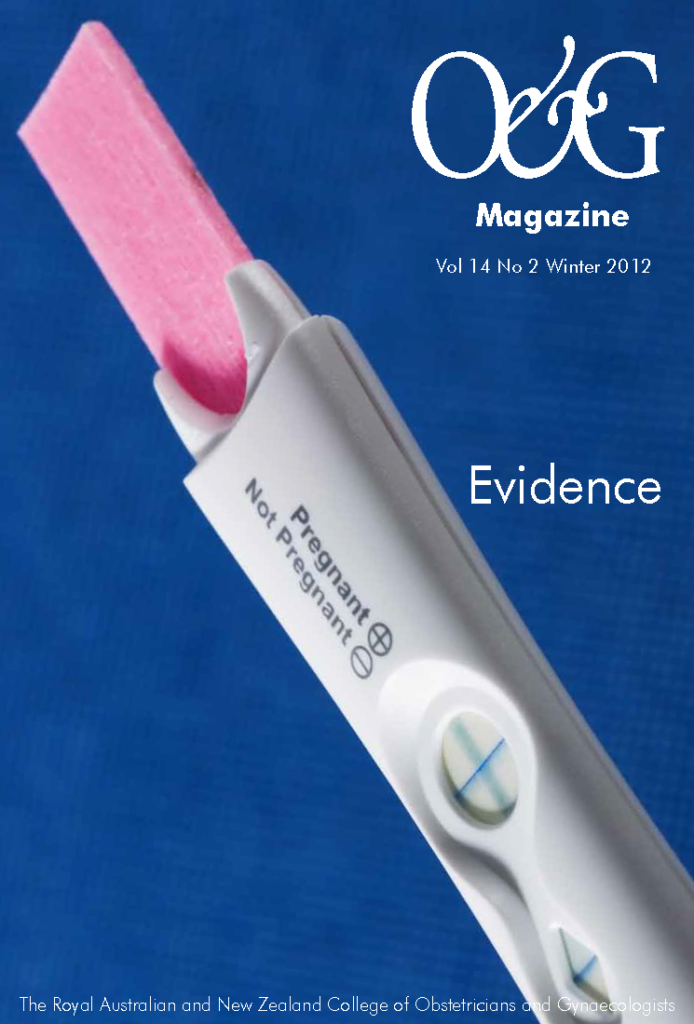Group B Streptococcus is a common commensal and a rare pathogen: what is the evidence for screening and treating pregnant women?
No article on streptococci can begin without mention of the incredible lifetime work of Dr Rebecca Lancefield (1895–1981). For 60 years, she categorised and published scientific papers on these occasionally pathogenic microbes, whose serotypes bear her name. Lancefield Group B Streptococcus, (GBS, also known as Streptococcus agalactiae), is a commensal organism of the rectum and lower genital tract in males and females. The most recent New Zealand prevalence data are from 2002, where GBS was detected in 22 per cent of women in Auckland and Wellington between 35 and 37 weeks gestation.1 This is consistent with similar studies in Australia and worldwide.
Though GBS is far more frequently detected in expectant mothers than syphilis, Hepatitis B and HIV, the vertical disease transmission rate is far lower, with only 12 per 1000 newborns of colonised mothers developing early-onset GBS (EOGBS) disease2, which is defined as infection occurring within seven days of birth. The majority – around 90 per cent – occur within 24 hours and are suspected to begin intrapartum by ascending colonisation into the amniotic fluid after membrane rupture. Though the attack rate is low, GBS is nevertheless the most frequent cause of severe early neonatal infection, with a mortality rate ranging between five and 20 per cent. It is thus an important problem.
The 1970s and 1980s
Knowledge of the existence of GBS as both a vaginal commensal and a neonatal pathogen led, inevitably, to the question of an intrapartum link, which was established in the 1970s with studies examining the serotypes which caused sepsis, meningitis and pneumonia in newborns. Epidemiologic studies showed that women colonised with GBS were 25 times more likely to deliver a baby with EOGBS than non-colonised controls. Additional risk factors were sought and elucidated in 1985: gestation <37 weeks, membrane rupture >12 hours, and/or intrapartum fever >37.5C are associated with a 6.5-fold increase in the risk of disease.3 These parameters remain part of many current GBS management guidelines.
In 1979, Yow showed that vertical transmission of GBS could be interrupted with the administration of intrapartum ampicillin, resulting in 0/34 neonates being colonised with the bacteria, compared to colonisation of 14/24 untreated neonates.4 Numerous repeat studies in the UK and Europe confirmed the finding. Then, in the 1986 landmark paper by Boyer and Gotoff, intrapartum chemoprophylaxis was found to reduce not only colonisation, but also found a zero per cent (treated) versus six per cent (untreated) rate of neonatal bacteraemia.5 Having demonstrated that the risk of EOGBS could be reduced by intrapartum chemoprophylaxis, the next question was whether this could be applied to the general antenatal population.
The 1990s
Understanding that penicillin and ampicillin could reduce the rate of EOGBS, researchers continued to search for strategies to best detect and manage GBS colonised antenatal patients and/or newborns likely to develop EOGBS. At this point two options predominated in clinical practice:
- GBS culture-based screening; and
- risk-factor-based GBS screening.
GBS culture-based screening has the following evidence basis:
- Studies have determined that for optimal detection of GBS, swabs should be collected from the lower vagina and rectum (same swab or separate swabs, clinician- or patient-collect).
- Specific microbiological techniques are used to culture and identify GBS, thus laboratory request forms must state the need for GBS culture. In patients with a penicillin allergy, sensitivity patterns must also be requested, as there is 15–30 per cent resistance to clindamycin and erythromycin, which are the main alternatives for prophylaxis in these patients.
- Because colonisation is transient within and between pregnancies, screening is required for each pregnancy.6 Gestation for GBS screening is ideally within five weeks of delivery. In practice this is 35–37 weeks.7
Risk-factor based GBS screening has the following evidence basis:
- Besides known GBS colonisation, maternal risk factors for delivering a neonate at risk of EOGBS have been elucidated and repeatedly confirmed by many observational studies8-11, and generally include gestation <37 weeks, membrane rupture >18hrs, intrapartum fever >37.5C, and low levels of maternal GBS capsular antibodies.
The method of treatment for screen-positive pregnant women has a strong evidence base. Studies confirm that both penicillin and ampicillin reduce neonatal colonisation and infection from GBS, with some effect seen when administered at least two hours before delivery, but a more certain effect if given at least four hours before delivery. As time of delivery is not usually able to be predicted accurately, four-hourly dosing is recommended.12 The principle of treatment is to achieve therapeutic concentrations of antibiotic in the amniotic fluid and fetal tissues. Observational studies have shown this form of chemoprophylaxis to be nearly 90 per cent effective in preventing EOGBS.
There are two groups of patients who are exempt from GBS screening, because risk factors independent of rectovaginal swab results make chemoprohylaxis mandatory. The first group is patients found to have GBS bacteruria during pregnancy. This has been shown to be a surrogate marker for heavy colonisation and, despite antibiotic eradication from the bladder, rectal/vaginal persistence is typical. The second group is patients who have had a previous neonate affected by EOGBS, which is thought to be due to reduced levels of maternal GBS capsular antibodies, which cross the placenta and are protective to the neonate.
Year 2000 and beyond
With both culture and risk-factor screening practices in place throughout the USA, a large multistate retrospective cohort study was published in 2002 to elucidate which of the two approaches was preferable.13 The results were conclusive. Patients who had undergone culture-based screening had less than half the risk of having a baby with EOGBS than patients who had had risk-factor based GBS screening (relative risk 0.46). This finding informed policies and guidelines on the prevention of EOGBS published by both the American Congress of Obstetricians and Gynecologists (ACOG) and Centers for Disease Control (CDC) later that year, which recommend culture-based screening.
Informing current practice
Where does that leave today’s practitioner? It appears to be dependent upon one’s geographic location. Despite aforementioned arguments favouring culture-based screening, the Royal College of Gynaecologists and Obstetricians (RCOG) notes that there is no RCT evidence comparing the two screening methods, either with each other or with no screening, in their efficacy at preventing EOGBS.14 The potential harms of false-negative swabs, penicillin anaphylaxis and antibiotic resistance are acknowledged. The RCOG has also noted that the UK rate of EOGBS (0.5/1000) is the same as that in the USA, without a structured and widely adhered-to GBS screening policy. Another RCOG report on GBS15 has found variation in international practice: of 14 guidelines: seven recommend culture-based screening, four recommend risk-factor screening, one suggested a combination approach (GBS culture collected, but only treated with prophylaxis if and when risk-factors develop) and one gave no preference. The current RANZCOG statement outlines both options, but gives no preference. Within New Zealand, across a range of units, guidelines suggest intrapartum prophylaxis for risk-factor positive patients, and an acknowledgement that late third-trimester swabs can be used to screen also, with a view to treatment if found to be positive for GBS.
In considering whether RANZCOG should produce a statement recommending culture-based screening for GBS, it may be worth revisiting the WHO guide for attributes of a successful screening test:
- The condition should be an important health problem. Yes: the leading cause of severe neonatal sepsis with a significant mortality rate.
- There should be a treatment for the condition. Yes: penicillin is at least 80 per cent effective.
- Facilities for diagnosis and treatment should be available. Yes: a microbiology lab and access to penicillin.
- There should be a latent stage of the disease. Yes: asymptomatic colonisation of the vagina before neonatal exposure.
- There should be a test or examination for the condition. Yes: the collection of swabs and microbiological techniques are well established.
- The test should be acceptable to the population. Yes: studies have shown high levels of patient acceptability, whether clinician- or patient-collected specimens.
- The natural history of the disease should be adequately understood. Yes: intrapartum transmission leads to neonatal colonisation and/or infection.
- There should be an agreed policy on who to treat. Yes: screen-positive individuals.
- The total cost of finding a case should be economically balanced in relation to medical expenditure as a whole. This requires further consideration and study due to the low attack rate and large numbers of screen-positive individuals requiring treatment to prevent cases.
- Case-finding should be a continuous process, not just a ‘once and for all’ project. Yes: there is an established body of work regarding the timing of swabs and the need to repeat the test each pregnancy.
Individual countries need to base their GBS screening guidelines on the resources available. At present, in Australasia, both risk-based and culture-based screening approaches are employed by individual practitioners within the same unit, depending on the individual’s response to the College statement. A RANZCOG statement that endorses a single preferred GBS screening approach would certainly help to achieve uniformity of practice. Unfortunately, definitive evidence to back one approach over the other is lacking.
Acknowledgement
I would like to thank Dr Martin Sowter for his assistance with this article.
References
- K eith Grimwood, Peter R Stone, Isobelle A Gosling, et al. Lateantenatal carriage of group B Streptococcus by New Zealandwomen. ANZJOG 2002; 42: 2: 182.
- Benitz WE, Gould JB, Druzin ML. Risk factors for early-onset groupB streptococcal sepsis: estimation of odds ratios by critical literaturereview. Pediatrics 1999;103:e77.
- Boyer KM, Gadzala CA, Kelly PD, et al. Selective intrapartumchemoprophylaxis of neonatal group B streptococcal early-onsetdisease. II. Predictive value of prenatal cultures. J Infect Dis1983;148:802-9
- Yow MD, Mason EO, Leroy JL, et al. Ampicillin Prevents IntrapartumTransmission of Group B Streptococcus. JAMA 241:1245-1247,1979
- Boyer KM, Gotoff SP. Prevention of Early-Onset Neonatal Group BStreptococcal Disease with Selective Intrapartum Chemoprophylaxis.N Engl J Med 1986; 314:1665-1669
- Yancey MK, Schuchat A, Brown LK, et al. The accuracy oflate antenatal screening cultures in predicting genital group Bstreptococcal colonization at delivery. Obstet Gynecol 1996;88:811-5.
- Valkenburg-van den Berg, Arijaan W. Houtman-Roelofsen, RebeccaL. Oostvogel, Paul M Dekker et al. Timing of group B streptococcusscreening in pregnancy: a systematic review. Gynecologic &Obstetric Investigation. 69(3):174-83, 2010.
- Boyer KM, Gadzala CA, Burd LI, et al. Selective intrapartumchemoprophylaxis of neonatal group B streptococcal early-onsetdisease. I. Epidemiologic rationale. J Infect Dis 1983;148:795-801.
- Schuchat A, Oxtoby M, Cochi S, et al. Population-based risk factorsfor neonatal group B streptococcal disease: results of a cohort studyin metropolitan Atlanta. J Infect Dis 1990;162:672-7.
- Schuchat A, Deaver-Robinson K, Plikaytis BD, et al. Multistatecase-control study of maternal risk factors for neonatal group Bstreptococcal disease. The Active Surveillance Study Group. PediatrInfect Dis J 1994;13:623-9.
- Schuchat A, Zywicki SS, Dinsmoor MJ, et al. Risk factors andopportunities for prevention of early-onset neonatal sepsis: amulticenter case-control study. Pediatrics 2000;105(1 Pt 1):21-6.
- Lin FY, Brenner RA, Johnson YR, et al. The effectiveness of risk-basedintrapartum chemoprophylaxis for the prevention of early-onsetneonatal group B streptococcal disease. Am J Obstet Gynecol2001;184:1204-10.
- Schrag SJ, Zell ER, Lynfield R, et al. A population-based comparisonof strategies to prevent early-onset group B streptococcal disease inneonates. New England Journal of Medicine. 347(4):233-9, 2002Jul 25.
- RCOG Greentop guideline no. 36, Nov 2003.
- The prevention of early-onset neonatal group B streptococcal diseasein UK Obstetric units. RCOG Press, Jan 2007.






Leave a Reply